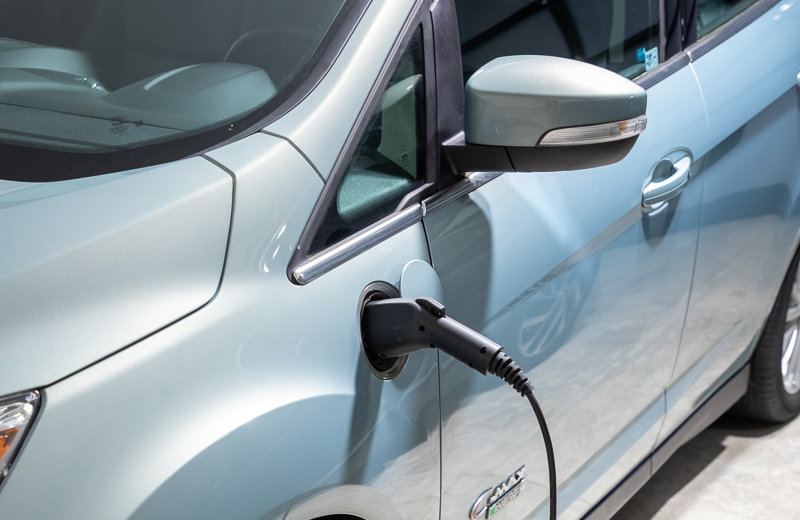As responsible stewards of the earth, we can all make a difference by minimizing our dependence on fossil fuels to power our homes. Weaning households off natural gas, heating oil, and other fossil fuels will significantly decrease carbon emissions, resulting in a cleaner, safer, healthier planet for future generations. If saving money and saving the environment interests you, here’s how to “flip the switch” on an all-electric home energy retrofit.
Benefits of All-Electric Homes
As part of the building electrification movement, many cities in the US have already banned natural gas in new home construction. That’s because a significant percentage of carbon emissions result from everyday household activities that require the use of gas-fired appliances, like clothes dryers, water heaters, furnaces, and stoves.
In addition to being more environmentally friendly than gas or oil, retrofitting your home with all-electric systems and appliances is cost-effective and better for your health. Explore the benefits of an all-electric home in detail below:
More Economical
The biggest gas guzzlers in a home are the HVAC system, water heater, stove, oven and dryer. According to a recent study by the Rocky Mountain Institute that analyzed cost comparison data from seven US cities, including Seattle, all-electric homes win hands down over mixed fuel homes for being more energy-efficient and cost-effective.
After accounting for startup installation and monthly bills, RMI’s energy experts determined that the average all-electric homeowner could see an annual cost savings of up to $6,800. Electric HVAC and water heating systems are often less expensive to install because there are no added costs for setting gas lines, services, or meters.
Upgrading to energy-efficient appliances and heating/cooling pumps, notably those with top Energy Star ratings, will reduce the amount of energy your household consumes. Combining rooftop solar plus storage with whole-home electrification could effectively eliminate your monthly utility bills altogether! Even in overcast Seattle, there are many success stories of people who power their homes on solar for most of the year.
Better Indoor Air Quality
Gas-powered appliances like furnaces, water heaters, and stoves produce significant amounts of nitrous oxide and carbon monoxide, neither of which is good for indoor air quality nor the earth’s atmosphere. Conversely, source control is one of the best ways to reduce indoor air pollution. To improve your home’s air quality, replace the offending polluting device or system, for example, a gas-fired stove or heater with a cleaner, all-electric version.
Is an All-Electric Home More Expensive?
Fortunately, home electrification is becoming more affordable as manufacturers in the construction industry seek innovative ways to address growing consumer demands. Transitioning an older house to all-electric appliances and systems doesn’t have to be done all at once.
Swapping out your gas-guzzling stove or water heater for an all-electric model when it breaks is an essential first step. When replacing a gas-burning appliance with an electric model, you may encounter minimal or no cost difference between the two options other than running nearby electricity to the new appliance. Be sure to check your local utilities for rebates, for example, Seattle City Light offers a $500 cash rebate on qualified heat pump water heaters and may offer similar rebates for other energy-efficient appliances.
You can spread retrofitting costs over several years by applying this same logic to your home’s HVAC system, clothes dryer, etc. Upgrade one thing at a time. Energy savings, in the long-term, could eventually outweigh the cost of the new appliances.
How to Retrofit an Energy Inefficient Old House
Electrifying your home is a step by step process, where you should think about every system and appliance in your home from top to bottom. Here’s how to start transforming your older house into an energy-efficient, eco-friendly, all-electric home:
Induction Stove (aka Induction Cooktop or Induction Range)

Arguably the easiest place to start is in your kitchen. The best eco-friendly choice for home cooking is induction, a process that relies on magnetism. Not only do induction stoves and ovens produce no air pollution, in most cases, they are also more energy-efficient to operate.
Very easy to clean, induction stoves only heat the pot or pan resting within the heating area and not the entire stovetop. The stovetop itself stays relatively cool, virtually eliminating the risk of fires or burns.
Induction stovetops on the market today are sleek, modern and come with a variety of smart features. Be sure the model you’re buying is listed as induction and not simply a glass electric range or an electric coil. Even professional chefs are making the switch to induction cooking!
Electric Water Heater or Electric Heat Pump for Water Heating
If your water heater is nearing the end of its useful life, usually at about 8-10 years, then it’s time to think about what you’ll replace it with. There are two electric options to choose from: regular electric or a heat pump.
A regular electric water heater is cost comparative to a gas one, but the electric version is more energy-efficient and better for the environment. Many people opt to take it one step further by upgrading to a tankless water heater, which is smaller and heats water instantly on-demand. Tankless units can be 24%–34% more energy efficient than conventional storage tank water heaters.
Although conventional electric water heaters are cheaper, heat pump water heaters (HPWHs) are even more environmentally-friendly. Also known as hybrid water heaters, they work by using an energy-efficient compressor to gather heat from the atmosphere and concentrate it in a water storage tank—like a refrigerator in reverse. If needed, most models can also heat extra water the conventional way, hence calling them hybrid.
Switching to a heat pump water heater is cost-competitive when considering the damage done to our environment when methane gas is involved. Plus, according to ENERGY STAR, a HPWH can save you up to $350 per year and $3,750 over the lifetime of the heater. Under many normal operating conditions, field studies of HPWHs revealed they often cost less to operate than gas-fired models. Installing “smart controls” on your HPWH will drive the operating costs down even further.
Switching from gas to electric for water heating usually means running new 240-volt lines, but not always. Getting a quote from a certified electrician is the best way to understand potential costs for your specific home. If the environment is your #1 concern, then switching to any form of electric from gas is definitely a no brainer.
Electric Heat Pump for Space Heating and Cooling
A geothermal source of electricity is one option when installing an all-electric HVAC system for your home. Unlike heat pump water heaters, these use the temperature of the earth below as the exchange medium instead of the outside air temperature. Since the initial cost is high, these systems are generally reserved for whole house remodels or new construction.
While the installation price of a geothermal system is high, long-term savings can be expected in 5-10 years. Plus, heat from the earth is a free, reliable, and renewable source of energy.
Ductless Mini-Spit Systems for Space Heating and Cooling

Mini-split systems are gaining popularity fast as one of the most efficient home heating and cooling systems. They are a great solution for retrofitting because they don’t require ductwork. They are a cost-effective way to condition old spaces without ductwork or new additions where ductwork is not feasible. Since ductwork can be a source of heat loss for homes, a mini-split system avoids that issue altogether. Typically, only a small hole in the wall for the conduit is needed to connect the two components of the system.
Mini-split systems work by using evaporator coils cooled with refrigerant to absorb heat from the air. There are two main components: an outdoor compressor/condenser and indoor air-handling unit. One outdoor unit can support many indoor units, creating the opportunity for “zoned” comfort with a separate control for each room’s temperature. Indoor units are suspended from the ceiling or mounted high on a wall to disperse the conditioned air throughout the room.
A mini-split system can accomplish both the heating and cooling for year-round comfort in temperate climates. You’ll need to work with a professional to determine which unit size is appropriate for each room, and for your particular geographic area.
Electric Infrared Heat Panels

Infrared heat panels work instantly, eliminating the need to preheat a room. Infrared works by converting electricity into radiant heat, which produces the same feeling that you get from standing out in the sun. Instead of heating the air, objects—namely people—are heated directly. Infrared heating is a great solution for small spaces, like a bathroom that is unserved by your main heating system or a small addition.
Some models use only 300 watts of electricity while almost 100 percent of the heat created is transferred out, allowing you to get super-efficient heating for a very reasonable cost. As an added benefit, infrared heaters require minimal maintenance.
Electric Car Charger

Electric vehicles (EVs), which operate on rechargeable batteries, are one of the fasted growing categories of automotives. EVs have zero tailpipe emissions and contribute far less to climate change than conventional gas-powered vehicles. They work Their battery storage and driving range is getting more and more efficient every year.
Though the initial cost of an EV can sometimes be higher, you’ll skip the steep bills at the pump. Installing solar panels on your roof you can likely supply all the electricity you’d need to power your EV.
If you’re considering a plug-in hybrid or all-electric vehicle in the future, you’ll need to prepare to charge it at home first. When doing an all-electric retrofit, ask your contractor to install circuit-sharing plugs. These devices allow one 240-volt outlet to power both an electric vehicle charger and an electric appliance.
Solar Panels
Harvesting energy from the sun is one of the most efficient and accessible forms of renewable energy for your home. Solar photovoltaic (PV) systems collect solar energy from the sun and convert it to electricity that feeds back into your home or local power grid.
According to Seattle City Light: “Currently in Seattle, the average residential solar electric system size is 8kW. This represents an investment of about $24,000 before incentives or taxes.” Though the investment is large, if you own your home and are planning on living there for 10+ years, it’s worth considering. An installer will develop a design plan for the panels and give you an estimate of how much electricity they expect their system to generate for your home. From this, you can determine what makes sense with your personal finances and environmental goals.
If solar power isn’t feasible, you can consider purchase green electricity from your local utility if it is offered.
Small Electric Appliances Can Make a Difference Too
You can also reduce your fossil fuel consumption by using electric countertop appliances. Using a toaster oven or air fryer, instead of firing up your gas oven, can help you save big on energy consumption and bills. The same goes for electric kettles, coffee makers, and pizza ovens.
Even smaller devices such as milk frothers and hand mixers can be found in rechargeable versions, which are more cost-effective and environmentally friendly than disposable battery or plug-in versions. Studies show that many appliances continue to draw a small amount of power from the outlet, even when they are switched off.
While this is not an exhaustive list of every way to switch to all-electric in your home, it’s a great place to start. If you have questions about retrofitting your home or incorporating electric options during a remodel, our team can help. At Model Remodel, sustainability is one of our core values as individuals and as a company. We’ve been building and retrofitting green homes in the Seattle area for over 20 years, and work with local certification agencies and green building supply stores to make sure our clients are getting the latest and most efficient technology available.






